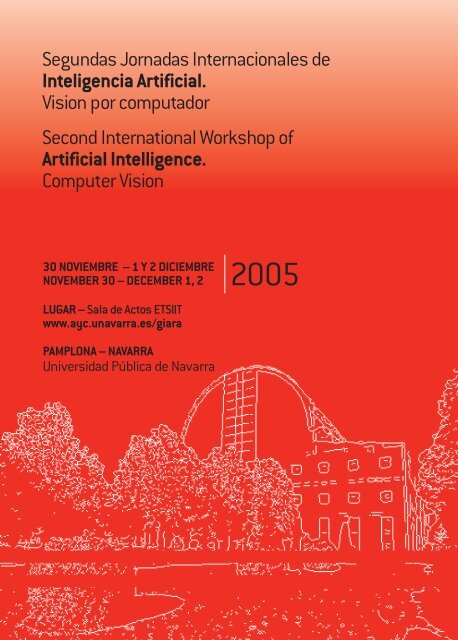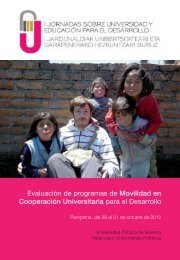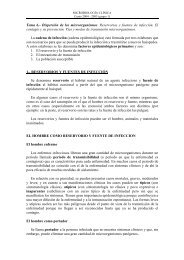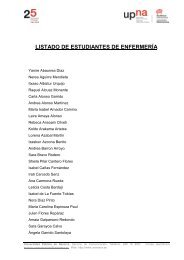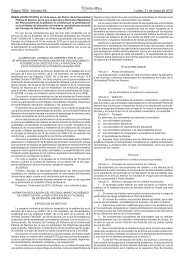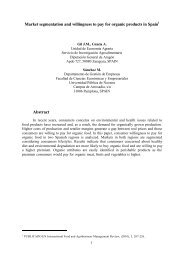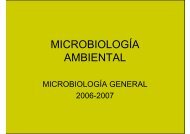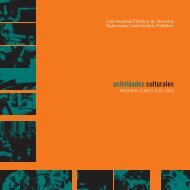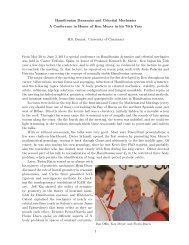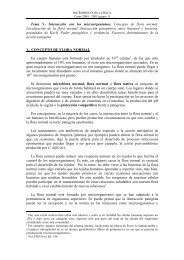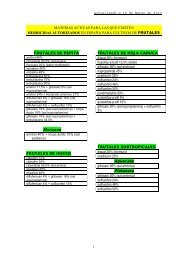folleto 2005 - GIARA - Universidad Pública de Navarra
folleto 2005 - GIARA - Universidad Pública de Navarra
folleto 2005 - GIARA - Universidad Pública de Navarra
You also want an ePaper? Increase the reach of your titles
YUMPU automatically turns print PDFs into web optimized ePapers that Google loves.
2 | 3II Jornadas Internacionales<strong>de</strong> Inteligencia ArtificialVisión por ComputadorPamplona30 <strong>de</strong> Noviembre1 y 2 <strong>de</strong> Diciembre<strong>de</strong> <strong>2005</strong>El objetivo <strong>de</strong> estas Jornadas es, continuando con la labor emprendidahace dos años, difundir los últimos avances en la investigación <strong>de</strong> la InteligenciaArtificial a nivel internacional. Para ello se ha conseguido reunira un grupo <strong>de</strong> investigadores nacionales y extranjeros cuyos trabajosfiguran entre los más relevantes <strong>de</strong> la comunidad científica internacionalen esta materia.Este año hacemos un especial hincapié en el campo <strong>de</strong> la Visión por Computador,tema puntero y <strong>de</strong> gran atractivo para un amplio sector <strong>de</strong> miembros<strong>de</strong> nuestra universidad.Estas jornadas han sido organizadas por el Grupo <strong>de</strong> Investigación <strong>de</strong> InteligenciaArtificial y Razonamiento Aproximado <strong>de</strong> la <strong>Universidad</strong> <strong>Pública</strong><strong>de</strong> <strong>Navarra</strong>.Agra<strong>de</strong>cemos la colaboración, sin la cual habría sido imposible este evento,a la Dirección General <strong>de</strong> <strong>Universidad</strong>es y Política Lingüística <strong>de</strong>lGobierno <strong>de</strong> <strong>Navarra</strong>, al Vicerrectorado <strong>de</strong> Convergencia Europea y RelacionesInstitucionales, a la Escuela Técnica Superior <strong>de</strong> Ingenieros Industrialesy Telecomunicación, al Departamento <strong>de</strong> Automática y Computacióny a Dreambox Animática.Comité Organizador:Dr. D. Humberto BustinceDra. Dña. Victoria MohedanoDña. Edurne BarrenecheaD. Miguel PagolaD. Carlos Guerra
8 | 9“Motion Analysis using Image Processing”Dr. Pedro José <strong>de</strong> Melo Teixeira Pinto<strong>Universidad</strong>e <strong>de</strong> Trás-os-Montes e Alto Douro, Vila Real, Portugal.Motion analysis has been important in many different fields over the years (e.g. medicine,sports, entertainment), and in recent times, with the ever growing power of thecomputing systems and with the evolution of digital vi<strong>de</strong>o cameras, the field has witnessedseveral <strong>de</strong>velopments.One of these <strong>de</strong>velopments is the importance of time integration and the changes thathigh time resolution sequences can bring to such integration.In or<strong>de</strong>r to do motion analysis one has to follow the object(s) of study. Several methodologiescan be used, such as optical flow and (markers’) tracking. Different problemsmay arise <strong>de</strong>pending on the chosen methodology - edge <strong>de</strong>tection, matching, etc. –where time integration can play an important role, and some problems are innate tothe process – occlusion of some parts/marks for instance.A 2D/3D tracking methodology will be presented, applied to two actual case studies:human gait analysis and a functional recovery analysis in animal mo<strong>de</strong>l (both studiesuse vi<strong>de</strong>o sequences with high time resolution coupled with data fromground reaction forces).“Análisis <strong>de</strong>l movimiento utilizando procesamiento <strong>de</strong> imágenes”El análisis <strong>de</strong>l movimiento ha sido importante en muchos y diversos campos a lo largo<strong>de</strong> los años (por ejemplo la medicina, el <strong>de</strong>porte, el entretenimiento), y recientemente,con el po<strong>de</strong>r en constante crecimiento <strong>de</strong> los sistemas informáticos y con laevolución <strong>de</strong> las cámaras <strong>de</strong> ví<strong>de</strong>o digitales, el campo ha sido testigo <strong>de</strong> varios <strong>de</strong>sarrollos.Uno <strong>de</strong> estos <strong>de</strong>sarrollos es la importancia <strong>de</strong> la integración <strong>de</strong>l tiempo y los cambiosque las secuencias <strong>de</strong> resolución “high time” pue<strong>de</strong>n traer a tal integración.Para hacer un análisis <strong>de</strong>l movimiento se tiene que seguir el/los objeto(s) <strong>de</strong> estudio.Se pue<strong>de</strong>n utilizar varias metodologías tales como flujo óptico y rastreo (<strong>de</strong> marcadores).Diferentes problemas pue<strong>de</strong>n surgir <strong>de</strong>pendiendo <strong>de</strong> la metodología elegida –<strong>de</strong>tección <strong>de</strong> bor<strong>de</strong>s, matching, etc. – don<strong>de</strong> la integración <strong>de</strong>l tiempo pue<strong>de</strong> jugar unpapel importante y algunos problemas son innatos al proceso – oclusión <strong>de</strong> algunaspartes/marcas por ejemplo.Se presentará una metodología <strong>de</strong> rastreo 2D/3D, aplicado a dos estudios <strong>de</strong> casosreales: el análisis <strong>de</strong>l caminar humano y un análisis <strong>de</strong> recuperación funcional en mo<strong>de</strong>loanimal (ambos estudios utilizan secuencias <strong>de</strong> ví<strong>de</strong>o con resolución “high time”junto con datos <strong>de</strong> la fuerza <strong>de</strong> reacción <strong>de</strong>l suelo).
IA. VISIÓN POR COMPUTADOR“Colour Image Comparison Using Vector Operators”Dr Dietrich van <strong>de</strong>r WekenGent Universiteit, Ghent BélgicaFuzzy techniques can be applied in several domains of image processing. In this presentationwe will see how fuzzy similarity measures can be used in establishing measuresfor colour image comparison. Objective quality measures or measures of comparisonare of great importance in the field of image processing. These measures serveas a tool to evaluate and to compare different algorithms <strong>de</strong>signed to solve particularproblems, such as noise reduction, <strong>de</strong>blurring, compression, ...Consequently thesemeasures serve as a basis on which one algorithm is preferred to another. Furthermore,it is well-known that classical quality measures, such as the RMSE (Root Mean SquareError) or the PSNR (Peak Signal to Noise Ratio), do not always correspond to visualobservations.We already constructed several new fuzzy similarity measures for greyscale imagesthat outperform the classical measures of comparison, like Root Mean Square Error orPeak Signal to Noise Ratio, in the sense of image quality evaluation. In this presentationI will illustrate the usefulness of similarity measures for the comparison of colourimages. Instead of applying the similarity measures for greyscale images componentwise,we will extend the similarity measures to colour images by applying vector morphologicaloperators. We will restrict ourselves to an investigation in the RGB colourspace.“Comparación <strong>de</strong> imágenes en color utilizando operadores vectores”Las técnicas difusas se pue<strong>de</strong>n aplicar varios dominios <strong>de</strong>l procesamiento <strong>de</strong> imágenes.En esta presentación veremos cómo las medidas <strong>de</strong> similaridad difusas pue<strong>de</strong>nutilizarse para establecer medidas para la comparación <strong>de</strong> imágenes en color. Las medidas<strong>de</strong> calidad objetiva o medidas <strong>de</strong> comparación son <strong>de</strong> gran importancia en elcampo <strong>de</strong>l procesamiento <strong>de</strong> imágenes. Estas medidas sirven como herramienta paraevaluar y comparar distintos algoritmos diseñados para resolver problemas particulares,tales como la reducción <strong>de</strong> ruido, <strong>de</strong>senborronamiento, compresión... En consecuenciaestas medidas sirven como base sobre la que preferir un algoritmo a otro.Por otra parte, es bien conocido que las medidas <strong>de</strong> calidad clásicas, tales como elRMSE (Root Mean Square Error- error cuadrático medio) o el PSNR (Peak Signal toNoise Ratio - relación señal-ruido <strong>de</strong> pico), no siempre correspon<strong>de</strong>n con las observacionesvisuales.Ya construimos varias nuevas medidas <strong>de</strong> similaridad para imágenes en escala <strong>de</strong> grisesque superan las medidas clásicas <strong>de</strong> comparación, como Root Mean Square Erroro Peak Signal to Noise Ratio, en el sentido <strong>de</strong> evaluación <strong>de</strong> calidad <strong>de</strong> imagen. En estapresentación ilustraré la utilidad <strong>de</strong> las medidas <strong>de</strong> similaridad para la comparación<strong>de</strong> imágenes en color. En lugar <strong>de</strong> aplicar las medidas <strong>de</strong> similaridad para las imágenesen escala <strong>de</strong> grises en sentido <strong>de</strong> componentes, exten<strong>de</strong>remos las medidas <strong>de</strong> similaridada las imágenes en color aplicando operadores morfológicos vectores. Noslimitaremos a la investigación en espacio <strong>de</strong> color RGB.
10 | 11“Classification Systems”Dr. Javier Montero<strong>Universidad</strong> Complutense <strong>de</strong> Madrid.This paper starts from a very particular problem, of how to classify the plant cover ofa piece of land from an image obtained by tele<strong>de</strong>tection, consi<strong>de</strong>ring in the first placethe visible spectrum and later going on to inclu<strong>de</strong> to the non-visible spectrum, insome cases more informative than the visible one. From this problem we ask ourselveshow the starting classification system should be: on the one hand we will see thesevere limitation it would mean to assume that our classes are clearly <strong>de</strong>fined, withstrict boundaries, which is why we consi<strong>de</strong>r the introduction of fuzzy classes. On theother hand, since the membership <strong>de</strong>gree to a class, in practice, cannot be consi<strong>de</strong>redin<strong>de</strong>pen<strong>de</strong>nt from the other classification options that are consi<strong>de</strong>red at each time, wewill justify that the solution to a problem of classification <strong>de</strong>mands the introduction ofa structured family of possible classes, without great initial requirements but with sufficientversatility and with the capacity to be systematically analyzed to enable learning,that is, the modification of the particular classification and even of the structureitself.Sistemas <strong>de</strong> clasificaciónEste trabajo parte <strong>de</strong> un problema muy particular, acerca <strong>de</strong> cómo clasificar la coberturavegetal <strong>de</strong> una porción <strong>de</strong> terreno a partir <strong>de</strong> una imagen obtenida por tele<strong>de</strong>tección,consi<strong>de</strong>rando en primer lugar el espectro visible para más a<strong>de</strong>lante dar elsalto e incluir el espectro no visible, en algunos casos más informativo que el espectrovisible. A partir <strong>de</strong> este problema nos planteamos cómo <strong>de</strong>biera ser el sistema <strong>de</strong>clasificación <strong>de</strong> partida: por una parte, veremos la grave limitación que implicaría suponerque nuestras clases están nítidamente <strong>de</strong>finidas, con fronteras estrictas, por loque nos plantearemos la introducción <strong>de</strong> clases difusas; por otra parte, como el grado<strong>de</strong> pertenencia a una clase, en la práctica, no pue<strong>de</strong> ser consi<strong>de</strong>rada in<strong>de</strong>pendiente<strong>de</strong> las otras opciones <strong>de</strong> clasificación que se se consi<strong>de</strong>ran en cada momento,justificaremos que la resolución <strong>de</strong> un problema <strong>de</strong> clasificación exige la introducción<strong>de</strong> una familia estructurada <strong>de</strong> posibles clases, sin gran<strong>de</strong>s exigencias iniciales perocon la suficiente versatilidad y dotada <strong>de</strong> capacidad <strong>de</strong> ser sistemáticamente analizadapara permitir el aprendizaje, es <strong>de</strong>cir, la modificación <strong>de</strong> la clasificaciónpuntual y hasta <strong>de</strong> la propia estructura.
IA. VISIÓN POR COMPUTADOR“Data Reduction in Knowledge Discovery”Dr. Francisco Herrera<strong>Universidad</strong> <strong>de</strong> Granada.In a knowledge extraction process from data bases it is necessary the use of data preparationtechniques due to we can find noise, inconsistencies, redundant data, etc. Thedata preparation goal is to obtain high quality data bases for extracting high qualitymo<strong>de</strong>ls, that is, mo<strong>de</strong>ls with high accuracy or mo<strong>de</strong>ls providing high quality information.We can find different tasks in a preprocessing process, such that, data clearing,data integration, data transformation and data reduction. We will focus ourpresentation on the data reduction approaches, presenting the most important techniques:discretization, feature selection and instance selection.“Técnicas <strong>de</strong> reducción <strong>de</strong> datos en los procesos <strong>de</strong> Minería <strong>de</strong> Datos”En el <strong>de</strong>scubrimiento <strong>de</strong> información en bases <strong>de</strong> datos, <strong>de</strong>bido al tamaño <strong>de</strong> las bases<strong>de</strong> datos, presencia <strong>de</strong> ruido, datos inconsistentes, redundantes, etc., se hace necesariala aplicación <strong>de</strong> técnicas <strong>de</strong> preprocesamiento sobre los conjuntos <strong>de</strong> datos.Dicho preprocesamiento persigue obtener conjuntos <strong>de</strong> datos tales que al aplicar técnicas<strong>de</strong> minería <strong>de</strong> datos sobre ellos se generen mo<strong>de</strong>los representativos con mayoresprestaciones. De entre las diferentes tareas que se pue<strong>de</strong>n <strong>de</strong>sarrollar en la etapa<strong>de</strong> preparación <strong>de</strong> los datos, centraremos la atención en la reducción <strong>de</strong> datos y sepresentaran las diferentes vías que se pue<strong>de</strong>n seguir para aplicarla.
12 | 13“On aggregation operators for information access on the web”Dr. Enrique Herrera<strong>Universidad</strong> <strong>de</strong> GranadaNowadays, the information access on the Web is a main problem in the computer sciencecommunity. Any major advance in the field of information access on the Web requiresthe collaboration of different methodologies and research areas. In this talk, theconcept of aggregation operator playing a role for information access on the Web isanalyzed. We present some Web methodologies, as search engines, recommendationssystems, and Web quality evaluation mo<strong>de</strong>ls, and analyze the way aggregation operatorshelp towards the success of their activities.“Sobre operadores <strong>de</strong> agregación para acceso a la información en la Red”Hoy en día, el acceso a la información en la Red es un problema principal en la comunidad<strong>de</strong> ciencias <strong>de</strong> la informática. Cualquier gran avance en el campo <strong>de</strong>l accesoa la información en la Red requiere la colaboración <strong>de</strong> distintas metodologías y áreas<strong>de</strong> investigación. En esta charla, se analiza el concepto <strong>de</strong> que los operadores <strong>de</strong>agregación juegan un papel para el acceso a la información en la Red. Presentamosalgunas metodologías Web, como buscadores, sistemas <strong>de</strong> recomendación y mo<strong>de</strong>los<strong>de</strong> evaluación <strong>de</strong> calidad Web y analizamos la manera en que los operadores <strong>de</strong>agregación contribuyen al éxito <strong>de</strong> sus activida<strong>de</strong>s.
IA. VISIÓN POR COMPUTADOR“Sensorial evaluation based on Decision making processes un<strong>de</strong>r Uncertainty”Dr. Luís Martínez<strong>Universidad</strong> <strong>de</strong> Jaén.In the real world we come across problems that try to evaluate different aspects of elements,processes etc., in accordance with the perceptions that humans obtain fromthem through their senses (taste, smell, touch, ..). This awareness implies uncertainty,which is why in this type of problems the information provi<strong>de</strong>d by the experts mustbe mo<strong>de</strong>lled and treated according to the certainty they have on it.Due to the relation existing between Decision making and evaluation processes, thelatter, in the case we are <strong>de</strong>aling with, can use <strong>de</strong>cision mo<strong>de</strong>ls for the treatment ofuncertainty for solving the processes of sensorial evaluation.“Evaluación Sensorial basada en procesos <strong>de</strong> Toma <strong>de</strong> Decisiones bajoIncertidumbre”En el mundo real nos encontramos con problemas que tratar <strong>de</strong> evaluar distintos aspectos<strong>de</strong> elementos, procesos, etc., <strong>de</strong> acuerdo a las percepciones que los humanosobtienen <strong>de</strong> los mismos a través <strong>de</strong> sus sentidos (gusto, olfato, tacto, ..). Este conocimientoimplica incertidumbre por lo que en este tipo <strong>de</strong> problemas la información queaporten los expertos <strong>de</strong>berá ser mo<strong>de</strong>lada y tratada según la certidumbre que tengasobre ella.Debido a la relación existente entre la Toma <strong>de</strong> Decisiones y los procesos <strong>de</strong> evaluación,éstos últimos en el caso que nos ocupa pue<strong>de</strong>n utilizar mo<strong>de</strong>los <strong>de</strong> <strong>de</strong>cisiónpara el tratamiento <strong>de</strong> la incertidumbre para resolver los procesos <strong>de</strong> evaluaciónsensorial.
14 | 15“Extension of classical collective <strong>de</strong>cision procedures to the setting ofgradual preferences.”Dr. Bonifacio Llamazares<strong>Universidad</strong> <strong>de</strong> Valladolid.There are many <strong>de</strong>cision making procedures that make it possible to obtain a collectivepreference from the individual preferences that a group of agents has on a set ofoptions. The simplest, though no less interesting, case occurs when only two alternativesare taken into account. However, the conventional voting procedures, amongwhich are some so commonly used in practice like simple, absolute and qualifiedmajority do not enable to express the intensity with which the agents prefer some optionsto others. In or<strong>de</strong>r to consi<strong>de</strong>r this possibility, the individual preferences can berepresented by values between 0 and 1. In this case the collective preference can beobtained through aggregation operators. A fundamental matter in this context isthe choice of operator, for which such choice can been ma<strong>de</strong> on the basis of the majority<strong>de</strong>cision making procedure that is <strong>de</strong>sired to appear in the aggregation processwhen the individuals do not rate their preferences among the options. This way theclassical <strong>de</strong>cision making procedures can be exten<strong>de</strong>d to the setting of gradual preferences.“Extensión <strong>de</strong> procedimientos <strong>de</strong> <strong>de</strong>cisión clásicos al ajuste <strong>de</strong> preferenciasgraduales”Existen muchos procedimientos <strong>de</strong> toma <strong>de</strong> <strong>de</strong>cisiones que hacen posible la obtención<strong>de</strong> preferencias colectivas, a partir <strong>de</strong> preferencias individuales que un grupo <strong>de</strong>agentes (sujetos) tiene en un conjunto <strong>de</strong> opciones. El caso más simple, aunque nomenos interesante, ocurre cuando se tienen en cuenta sólo dos alternativas. Sin embargo,los procesos convencionales <strong>de</strong> voto, entre los cuales están algunos muy comúnmenteutilizados como la mayoría simple, absoluta y cualificada, no expresan laintensidad con la que los agentes (sujetos) prefieren algunas opciones frente a otras.Al tomar en consi<strong>de</strong>ración esta posibilidad, las preferencias individuales pue<strong>de</strong>n serrepresentadas por valores entre 0 y 1. En este caso la preferencia colectiva pue<strong>de</strong> serobtenida mediante operadores <strong>de</strong> agregación. Una cuestión fundamental en este contextoes la elección <strong>de</strong>l operador, la cual pue<strong>de</strong> estar basada en el proceso <strong>de</strong> toma <strong>de</strong><strong>de</strong>cisiones por mayoría, que se <strong>de</strong>sea aparezca en el proceso <strong>de</strong> agregación cuandolos individuos no tasan sus preferencias <strong>de</strong> las opciones. De esta manera los procedimientos<strong>de</strong> toma <strong>de</strong> <strong>de</strong>cisión clásicos pue<strong>de</strong>n ser extendidos al conjunto <strong>de</strong> preferenciasgraduales.
IA. VISIÓN POR COMPUTADOR“Computer vision system for automatic cervical-vaginal cytology screeningbased on fuzzy techniques”Pilar Sobrevilla, Eduard Montseny, Enrique LermaUniversitat Politècnica <strong>de</strong> CatalunyaCervical-vaginal cytology, or Papanicolaou test, for early uterine cervix cancer diagnosis,has proven a clear social-sanitary validity for reducing the inci<strong>de</strong>nce and mortalityof this disease.The diagnosis from a cervical-vaginal cytology has two fundamental steps, in thefirst place the cytotechnologist examines the cells’ morphological characteristics, relateshis/her observations with the patient’s medical records, and gives his/her cytologicalimpression. Then the cytopathologist diagnoses the disease, if it exists, by analyzingthe cells previously selected by the cytotechnologist. This is a slow, monotonous,and tedious job, whose automatization in the laboratory would enable to extend thefulfilment of this control, having an effect on the increase of early <strong>de</strong>tection of this typeof cancer, and reducing the errors in the final diagnosis. Furthermore, the automatizationof the process would enable to reduce the costs associated to these analyses, forthe false positives and negatives would be reduced.The i<strong>de</strong>a is to <strong>de</strong>velop a computer system that will aid the technician with the automaticlocalization of all the abnormal cells that can be cancerous type according to theobjective criteria indicated by the cytopathologist.“Sistema <strong>de</strong> visión por computador para el cribado automático <strong>de</strong> citologíascérvico-vaginales basado en técnicas difusas “La citología cérvico-vaginal, o test <strong>de</strong> Papanicolaou, para el diagnóstico precoz <strong>de</strong>lcáncer <strong>de</strong> cervix uterino, ha <strong>de</strong>mostrado una clara vali<strong>de</strong>z socio-sanitaria para reducirla inci<strong>de</strong>ncia y mortalidad por esta enfermedad.El diagnóstico <strong>de</strong> una citología cérvico-vaginal tiene dos pasos fundamentales, en primerlugar el cito-tecnólogo examina las características morfológicas <strong>de</strong> las células, relacionasus observaciones con el historial clínico <strong>de</strong> la paciente, y da su impresión citológica.Posteriormente, el cito patólogo diagnostica la enfermedad, si existe, analizandolas células previamente seleccionadas por el cito-tecnólogo. Este es un trabajo lento,monótono y tedioso, cuya automatización en el laboratorio permitiría exten<strong>de</strong>r la realización<strong>de</strong> este control, incidiría en un incremento en la <strong>de</strong>tección precoz <strong>de</strong> estetipo <strong>de</strong> cáncer, y reducir los errores en el diagnóstico final. Por otra parte, la automatización<strong>de</strong>l proceso permitiría reducir los costes asociados a estos análisis, puesto quese reducirían los falsos positivos y negativos.Se preten<strong>de</strong> <strong>de</strong>sarrollar un sistema informático que ayu<strong>de</strong> al técnico en la localizaciónautomática <strong>de</strong> todas aquellas células anormales que pue<strong>de</strong>n ser <strong>de</strong> tipo canceroso <strong>de</strong>acuerdo con los criterios objetivos indicados por el cito-patólogo.
16 | 17“Contradiction in intuitionistic or Atanassov’s sets”Dra. Susana Cubillo<strong>Universidad</strong> Politécnica <strong>de</strong> Madrid.Fuzzy logic enables us to make inferences with predicates that are not clear, that is,predicates that are verified by the elements of a universe with values different from0 and 1. But when making these inferences it is necessary to make sure that the resultsare not contradictory, that is, a predicate that implies its own negation should not beobtained, that is to say, that the set that represents it should not be contained in itscomplementary. However, whereas in classical logic the only contradictory set is theempty one, for it is the only one contained in its complementary, the total set, in thefuzzy case, the property of being contradictory extends to many more sets.Furthermore, in 1983 K.T. Atanassov introduced the concept of intuitionistic fuzzyset. His starting point is the observation that a predicate is not only <strong>de</strong>termined by the<strong>de</strong>gree to which each object of the universe verifies it, but also by the <strong>de</strong>gree to whichit does not verify it, with a margin of doubt or in<strong>de</strong>cision remaining, in general otherthan zero.The i<strong>de</strong>a of contradiction in intuitionistic sets is approached in a way similar to thefuzzy case: an intuitionistic fuzzy set will be contradictory if the predicate it representsimplies its own negation. Moreover, this property can be verified in different <strong>de</strong>greesor levels, which requires obtaining mathematical instruments to measure them. Forthis objective, the concept of “implying” is previously formalized, which can be donein at least two different ways resulting in two different ways of obtaining different measuresof contradiction.“Contradicción en conjuntos intuicionistas o <strong>de</strong> Atanassov”La lógica borrosa nos permite hacer inferencias con predicados que no son nítidos, es<strong>de</strong>cir, predicados que son verificados por los elementos <strong>de</strong> un universo con valoresdistintos <strong>de</strong> 0 y 1. Pero al hacer estas inferencias es necesario asegurarnos <strong>de</strong> que losresultados no sean contradictorios, es <strong>de</strong>cir, que no se obtenga un predicado queimplique su propia negación, o lo que es lo mismo, que el conjunto que lo representa,no esté contenido en su complementario. Ahora bien, mientras que en la lógica clásica,el único conjunto contradictorio es el vacío, ya que es el único contenido en sucomplementario, el conjunto total, en el caso borroso, la propiedad <strong>de</strong> ser contradictoriose extien<strong>de</strong> a muchos más conjuntos.Por otra parte, en 1983 K.T. Atanassov introdujo el concepto <strong>de</strong> conjunto borroso intuicionista.Su punto <strong>de</strong> partida es la observación <strong>de</strong> que un predicado no solamentequeda <strong>de</strong>terminado por el grado en que cada objeto <strong>de</strong>l universo lo verifica, sino tambiénpor el grado en que no lo verifica, quedando un margen <strong>de</strong> duda o in<strong>de</strong>cisión, engeneral distinto <strong>de</strong> cero.La i<strong>de</strong>a <strong>de</strong> contradicción en los conjuntos intuicionistas es abordada <strong>de</strong> forma similaral caso borroso: un conjunto borroso intuicionista será contradictorio si el predicado
IA. VISIÓN POR COMPUTADORque representa implica su propia negación. A<strong>de</strong>más, esta propiedad se pue<strong>de</strong> verificaren distintos grados o niveles, lo que hace necesario la obtención <strong>de</strong> instrumentosmatemáticos para medir los mismos. Para este objetivo, previamente, se formaliza elconcepto “implicar”, lo que se pue<strong>de</strong> llevar a cabo <strong>de</strong>, al menos, dos formas distintas,dando lugar a dos vías diferentes para la obtención <strong>de</strong> diversas medidas <strong>de</strong> contradicción.
18 | 19“Type-2 Fuzzy Logic and the Mo<strong>de</strong>lling of Uncertainty”Dr. Robert I. Bob JohnDe Monfort University, Leicester, EnglandThis talk presents type-2 fuzzy sets and their role in mo<strong>de</strong>lling uncertainty and imprecision.Traditional fuzzy logic (type-1 fuzzy logic), it is argued here, is actually crisp anddoes not capture many of the uncertainties that exist in real world applications. Type-2 fuzzy sets were originally proposed by Za<strong>de</strong>h in 1975 and are essentially ‘fuzzy fuzzy’sets where the membership gra<strong>de</strong>s are type-1 fuzzy sets. The talk will provi<strong>de</strong> an overviewof type-2 fuzzy sets and their operations. Some applications of type-2 fuzzy logicwill be briefly mentioned and, finally, Professor John will give a personal view onsome directions for fuzzy logic research.“Lógica difusa Tipo-2 y el mo<strong>de</strong>lado <strong>de</strong> la incertidumbre”Esta charla presenta conjuntos difusos tipo-2 y su papel en el mo<strong>de</strong>lado <strong>de</strong> la incertidumbrey la imprecisión. La lógica difusa tradicional (lógica difusa tipo-1), se argumentaaquí, es en realidad crisp y no capta muchas <strong>de</strong> las incertidumbres que existenen las aplicaciones <strong>de</strong>l mundo real. Los conjuntos difusos tipo-2 fueron originalmentepropuestos por Za<strong>de</strong>h en 1975 y son esencialmente conjuntos “difusos difusos” en losque los grados <strong>de</strong> pertenencia son conjuntos difusos tipo-1. La charla proporcionaráuna visión general <strong>de</strong> los conjuntos difusos tipo-2 y sus operaciones. Se mencionaránbrevemente algunas <strong>de</strong> las aplicaciones <strong>de</strong> la lógica difusa tipo-2, y finalmente elProfesor John dará su punto <strong>de</strong> vista personal sobre algunas líneas <strong>de</strong> investigaciónen la lógica difusa.
IA. VISIÓN POR COMPUTADOR“Group Decision Making with Incomplete Fuzzy Preference Relations basedon Additive Consistency”Dr. Francisco ChiclanaDe Montfort University, Leicester, Inglaterra.In <strong>de</strong>cision-making problems there may be cases in which experts do not have an in<strong>de</strong>pthknowledge of the problem to be solved. In such cases, experts may not put theiropinion forward about certain aspect of the problem, and as a result they may presentincomplete preferences, i.e. some preference values may not be given or may bemissing. In this talk a new Mo<strong>de</strong>l for Group Decision-Making in which experts' preferencescan be expressed as incomplete fuzzy preference relations is presented.As part of this <strong>de</strong>cision mo<strong>de</strong>l, an iterative procedure to estimate the missing informationin an expert's incomplete fuzzy preference relation is proposed. This procedure isgui<strong>de</strong>d by the additive consistency property and only uses the preference values theexpert provi<strong>de</strong>s. The additive consistency property in conjunction with the completenessconcept is also used to measure the level of consistency of the information provi<strong>de</strong>dby the experts and also to propose the AC-IOWA operator, which permits theaggregation of the experts' preferences in such a way that more importance is givento the most consistent ones.“Toma <strong>de</strong> <strong>de</strong>cisiones en grupo con relaciones <strong>de</strong> preferencia difusas incompletasbasado en la consistencia aditiva”En problemas <strong>de</strong> toma <strong>de</strong> <strong>de</strong>cisiones pue<strong>de</strong> haber casos en los que los expertos notengan un conocimiento en profundidad <strong>de</strong>l problema a resolver. En tales casos pue<strong>de</strong>que los expertos no <strong>de</strong>n su opinión acerca <strong>de</strong> ciertos aspectos <strong>de</strong>l problema y comoresultado pue<strong>de</strong>n presentar preferencias incompletas, por ejemplo pue<strong>de</strong> que nose <strong>de</strong>n o que falten algunos <strong>de</strong> los valores <strong>de</strong> preferencia. En esta charla se presentaun nuevo mo<strong>de</strong>lo para la toma <strong>de</strong> <strong>de</strong>cisiones en grupo en el que las preferencias <strong>de</strong>los expertos se pue<strong>de</strong>n expresar como relaciones <strong>de</strong> preferencias difusas incompletas.Como parte <strong>de</strong> este mo<strong>de</strong>lo <strong>de</strong> <strong>de</strong>cisión se propone un procedimiento iterativo paraestimar la información que falta en una relación <strong>de</strong> preferencias difusa <strong>de</strong> un experto.Este procedimiento está dirigido por la propiedad <strong>de</strong> consistencia aditiva y solamenteutiliza los valores <strong>de</strong> preferencia que proporciona el experto. La propiedad <strong>de</strong>consistencia aditiva conjuntamente con el concepto <strong>de</strong> integridad también se usa paramedir el nivel <strong>de</strong> consistencia <strong>de</strong> la información proporcionada por los expertos ytambién para proponer el operador AC-IOWA, que permita la agregación <strong>de</strong> las preferencias<strong>de</strong> los expertos <strong>de</strong> tal manera que se da más importancia a las más consistentes.
20 | 21"Construction of general aggregation operators of arbitrary dimension"Dr. Gleb BeliakovDeakin University, Clayton, Australia.Aggregation operators are frequently used in expert systems and <strong>de</strong>cision supportsystems. An important practical problem is how to construct these operators with the<strong>de</strong>sired properties.In this presentation I am going to consi<strong>de</strong>r the infinite families of aggregation operatorsof different dimensions and I will present some techniques for the construction ofthese families. In particular I am going to use the associativity of t-norms, t-conorms,uninorms and nullnorms, the properties of the generalized means and generating functionsof OWA operators and of the Choquet integral."Construcción <strong>de</strong> los operadores <strong>de</strong> agregación generales <strong>de</strong> dimensiónarbitraria"Los operadores <strong>de</strong> agregación se usan frecuentemente en los sistemas expertos y sistemas<strong>de</strong> apoyo a la <strong>de</strong>cisión. Un problema práctico importante es como construir estosoperadores con las propieda<strong>de</strong>s <strong>de</strong>seadas.En esta presentación voy a consi<strong>de</strong>rar las familias infinitas <strong>de</strong> los operadores <strong>de</strong>agregación <strong>de</strong> diferentes dimensiones, y presentaré unas técnicas <strong>de</strong> construcción <strong>de</strong>estas familias. En particular utilizaré la asociatividad <strong>de</strong> t-normas, t-conormas, uninormasy nulnormas, las propieda<strong>de</strong>s <strong>de</strong> los promedios generalizados, y funciones generatrices<strong>de</strong> los operadores OWA y <strong>de</strong> la integral <strong>de</strong> Choquet.
IA. VISIÓN POR COMPUTADOR“How to incorporate weights into aggregation Process?”Dra. Tomasa Calvo<strong>Universidad</strong> <strong>de</strong> Alcalá <strong>de</strong> Henares.Basic fusion techniques in many applied fields are linked to the anonymous (symmetric)aggregation operators, such as the sum, product, median, etc. Different reliabilityof sources of information, different importances of criteria, different weights of singlevoters, etc., are typical examples for the need of incorporation of weights (importances)into the fusion process. The aim of this work is a presentation of methods leadingto weighted aggregation operators. Presented methods cover and generalizethe majority of weighting techniques known from the literature.Firstly, a new class of weighted means is proposed by means of a generalization ofweighted quasi--arithmetic means for t--norms and t--conorms. This class is exten<strong>de</strong>dto weighted triangular norms--based aggregation operators, including weighted uninorms,nullnorms, gamma operators, etc. The next consi<strong>de</strong>ration is <strong>de</strong>voted to theintroduction of weights into anonymous aggregation process (i.e., symmetric aggregationoperator). First, we <strong>de</strong>scribe a general method of incorporating quantitativeweights into aggregation. This method is based on a newly introduced property ofaggregation operators, so--called strong i<strong>de</strong>mpotency, generalizing the standard i<strong>de</strong>mpotencyof aggregation operators. This approach applied to the continuous t--normsand t--conorms gives the same results as that in 6, whenever it can be applied, as wewill illustrate in this section. However, qualitative weights are applied to aggregationoperators with neutral element. Moreover, the introduction of weights into composedaggregation operators is discussed. Finally, the work <strong>de</strong>als with the integral—basedaggregation operators.“¿Cómo incorporar pesos al proceso <strong>de</strong> agregación?”Las técnicas básicas <strong>de</strong> fusión en muchos campos aplicados están ligados a los operadores<strong>de</strong> agregación anónimos (simétricos), tales como la suma, el producto, el puntomedio etc. Las diferencias en fiabilidad <strong>de</strong> las fuentes <strong>de</strong> información, en importancias<strong>de</strong> criterios, en pesos <strong>de</strong> votantes individuales, etc. son ejemplos típicos <strong>de</strong> lanecesidad <strong>de</strong> incorporar pesos (importancias) al proceso <strong>de</strong> fusión. El objetivo <strong>de</strong>este trabajo es la presentación <strong>de</strong> métodos que conduzcan a operadores <strong>de</strong> agregaciónpon<strong>de</strong>rados. Los métodos presentados cubren y generalizan la mayoría <strong>de</strong> lastécnicas <strong>de</strong> pon<strong>de</strong>ración conocidas en la literatura.En primer lugar se propone una nueva clase <strong>de</strong> media pon<strong>de</strong>rada a través <strong>de</strong> la generalización<strong>de</strong> la media cuasi-aritmética pon<strong>de</strong>rada para t-normas y t-conormas. Estaclase se extien<strong>de</strong> a operadores <strong>de</strong> agregación basados en normas triangulares pon<strong>de</strong>radas,incluyendo uninormas pon<strong>de</strong>radas, nulnormas, operadores gamma, etc. Lasiguiente consi<strong>de</strong>ración está <strong>de</strong>dicada a la introducción <strong>de</strong> pesos en el proceso <strong>de</strong>agregación anónimo (es <strong>de</strong>cir, operador <strong>de</strong> agregación simétrico). Primero <strong>de</strong>scribimosun método general <strong>de</strong> incorporar pesos cuantitativos a la agregación. Este mé-
22 | 23todo se basa en la recientemente presentada propiedad <strong>de</strong> los operadores <strong>de</strong> agregación,llamada i<strong>de</strong>mpotencia, generalizando la i<strong>de</strong>mpotencia estándar <strong>de</strong> los operadores<strong>de</strong> agregación. Este planteamiento aplicado a las t-normas y t-conormas continuasda el mismo resultado que en 6, siempre que se pueda aplicar, como ilustraremosen esta sección. Sin embargo los pesos cualitativos se aplican a los operadores <strong>de</strong> agregacióncon elemento neutral. A<strong>de</strong>más, se trata la introducción <strong>de</strong> pesos en operadores<strong>de</strong> agregación compuestos. Finalmente, este trabajo trata <strong>de</strong> los operadores agregaciónbasados en integrales.
ORGANIZADO POR ORGANIZED BYGrupo <strong>de</strong> investigaciónInteligencia Artificial y Razonamiento AproximadoResearch Group ofArtificial Intelligence and Approximate ReasoningSUBVENCIONAN SPONSORSVicerectorado <strong>de</strong> Convergencia Europea y RelacionesInstitucionalesEscuela Técnica Superior <strong>de</strong> Ingenieros Industriales yTelecomunicación ETSIITDepartamento <strong>de</strong>Automática y Computación


